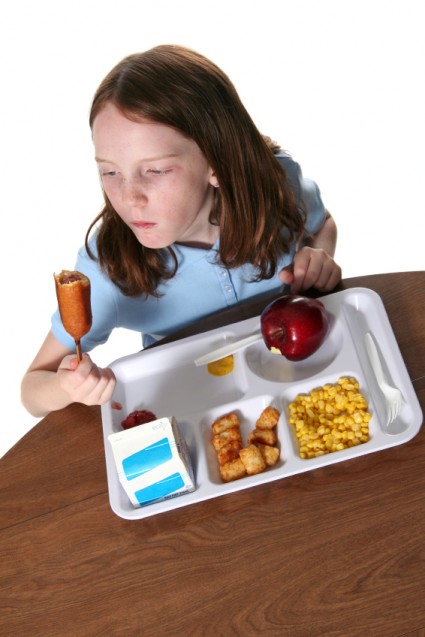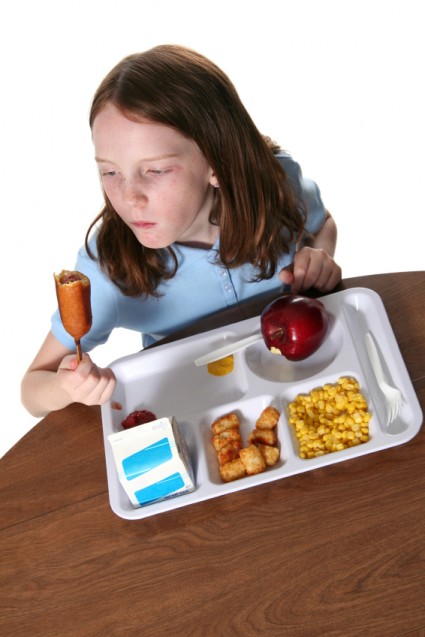 A new study from the University of Michigan finds that kids who eat the food served in schools are more likely to be overweight or obese than peers who bring lunch from home, and also are more likely to suffer from high levels of “bad” cholesterol.
A new study from the University of Michigan finds that kids who eat the food served in schools are more likely to be overweight or obese than peers who bring lunch from home, and also are more likely to suffer from high levels of “bad” cholesterol.
The study, which examined the eating habits of some 1,300 Michigan sixth-graders over a three-year period, found that children who get their food at school eat more fat, drink more sugary sodas, and consume far fewer fruits and vegetables. The findings, presented last week at the American College of Cardiology annual scientific session, are said to be the first to assess the impact of school food on children’s eating behaviors and overall health.
Specifically, 38.8 percent of students who routinely eat school lunch were found to be overweight or obese, compared to 24.4 percent of kids who brought their own food from home. The children consuming school food were twice as likely to drink sodas, and a measly 16.3 percent reported eating fruits and vegetables on a regular basis, compared to 91.2 percent of the kids who got homemade food.
“This study confirms the current and escalating national concern with children’s health, and underscores the need to educate children about how to make healthy eating and lifestyle choices early on,” said Elizabeth Jackson, M.D., MPH, assistant professor of internal medicine at the University of Michigan Health System, in a release put out by the university. “Although this study doesn’t provide specific information on nutrient content of school lunches, it suggests there is a real opportunity to promote healthy behaviors and eating habits within the school environment. This is where kids spend a majority of their time.”
It would be dangerous to read too much into a study that is based solely on student questionnaires and suggests correlations, not cause and effect, between self-reported eating habits and specific health issues. For instance, it could be that children who tend to be overweight or obese must eat the food served at school because they get it free courtesy of the federally-subsidized school lunch program. The researchers acknowledge that there could be a correlation “between socioeconomic status and heart health in children of low-income families who take advantage of free school meal programs.”
The findings, based on what students reported about their eating habits during the entire day, not just at school, certainly suggest a strong link between what kids learn about food at home and the kinds of food they choose at school. But even parents who pack “healthful” lunches can never be sure what their children are actually eating, the researchers report, since most children in public schools are exposed to “competitive” foods — those sold outside the regular lunch line — that encompass all kinds of junk food, as well as the stuff sold in vending machines.
What’s more, only 7 percent of school food operations fully comply with the nutrtional standards laid down by the U.S. Department of Agriculture for the federal meals program. During the week I spent recently in the kitchen at my daughter’s school here in the District of Columbia, it was clear that schools trying to feed kids on a budget rely heavily on industrially-processed convenience foods laced with additives and sugar. Fresh vegetables are a rarity.
A study of how schools use government donations of surplus farm commodities, conducted by the Robert Woods Johnson Foundation (PFD) two years ago, found that California schools ordered far more meat and dairy products and rarely touched the offerings of fresh vegetables and whole grains. The reason is simple enough: kids don’t like vegetables and whole grains. Unless, of course, they’ve already been trained to like them at home.
The University of Michigan researchers said they are encouraged by a recent movement toward exposing children to fresh, local produce and programs that encourage children to walk to school and exercise more — just the sort of things being pushed by Michelle Obama in her “Let’s Move” campaign, as well as “Healthy Schools” legislation pending here in the District of Columbia. The USDA also is considering new school food standards developed by the Institute of Medicine that would put a cap on the number of calories served in school meals, reduce starchy foods, and increase servings of fruits, vegetables and whole grains.
The University of Michigan study comes as Congress considers re-authorization of the Child Nutrition Act, for which President Barack Obama has proposed splitting an additional $1 billion annually between school meals and other food programs. Some advocates say that amount is not even enough to put an apple on kids’ cafeteria trays. Ann Cooper, the “renegade lunch lady,” in a recent op-ed in The Washington Post, says what schools really need is another $1 per day for each child in the federal program, which would work out to something like $5.4 billion a year.
But this latest study points to something even more ominous that should occupy the attention of federal lawmakers: a growing bifurcation of the food system wherein poor kids are routinely subjected to cheap processed food that damages their health, while kids from wealthier families get access to the best our local farms have to offer. That is the underlying message of the growing Farm to School movement: that all kids deserve fresh, wholesome food, not just the ones whose parents shop at Whole Foods or the farmers market.
More studies like this one will undoubtedly show that school food quality is a social justice issue that demands immediate attention. And while some politicians might be loathe to pay for improving it — that is, if they think about it at all — it is also a health issue with potentially devastating consequences for the national budget.



